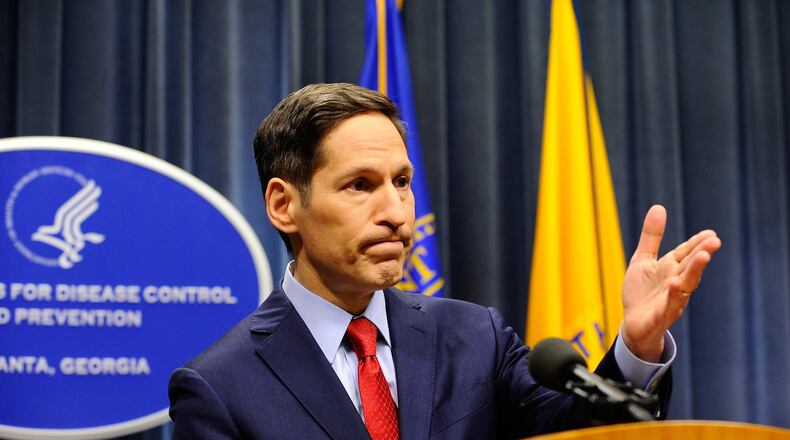A lab mistake may have exposed a technician to Ebola at the Atlanta-based Centers for Disease Control and Prevention, officials said Wednesday.
The technician was potentially exposed Monday after a sample containing the virus was mistakenly transferred to a less secure lab, where the technician worked on it without wearing proper safety equipment, said agency spokeswoman Barbara Reynolds.
The technician currently has no symptoms and will be monitored for 21 days, which is the incubation period for the illness. About a dozen others who entered the lab were also assessed for possible exposure, and officials told The Atlanta Journal-Constitution that none of the workers so far appears to have been exposed.
Officials say the potential exposure was limited to the CDC lab, and there was no risk of exposure to the public.
“It’s highly unlikely the lab tech was exposed,” said CDC spokesman Tom Skinner.
He said it remains unclear whether there was live Ebola virus in the specimen. In addition, the technician was not performing a procedure that would elevate the risk of exposure. The specimen was small and the procedure did not include any action that may have dispersed it, Skinner said.
The mistake, which was discovered Tuesday, represents another in a series of lab blunders by the agency this year. No one was injured in those incidents, which involved the mishandling of anthrax and deadly bird flu. But they led CDC Director Tom Frieden to tell Congress this summer that his agency has “an insufficient culture of safety,” even as he promised reforms. The head of the CDC’s anthrax lab soon after resigned.
This latest incident raised new concerns among experts.
“Why did it happen again?” said Dr. Dennis Maki, a University of Wisconsin-Madison infectious disease specialist. He said the CDC had existed for decades with a pristine reputation. “It suggests something has changed in the culture.”
In June, CDC employees failed to completely kill anthrax before sending samples to two other CDC labs with fewer safeguards, potentially exposing dozens of employees to the live pathogen. The CDC’s vaunted influenza lab was thrust into a harsh spotlight when relatively harmless bird flu was accidentally contaminated with a much deadlier strain, and then sent to a lab run by the U.S. Agriculture Department. The incident was discovered in May but not reported to the agency’s top brass until July.
“I am troubled by this incident in our Ebola research laboratory in Atlanta,” Frieden said in a statement Wednesday. “We are monitoring the health of one technician who could possibly have been exposed and I have directed that there be a full review of every aspect of the incident and that CDC take all necessary measures.”
This week’s incident occurred when staff mixed up two sets of samples of the Ebola virus, Reynolds said. One set, in which the virus had been killed, was placed in storage in the high-security BSL-4 lab.
Another set of samples, which may still have contained live virus, was wrongly transferred to the less secure BSL-2 lab, where a technician worked on it, she said. The technician was wearing gloves and a gown but no face shield.
BSL-4 labs contain the highest level of security, in which workers wear full body suits, whereas the BSL-2 lab workers wear gowns, gloves and other equipment.
The samples were secured in such a way as to preclude any contamination during the transfer, Reynolds said. The material was on a sealed plate, but should not have been moved into a less secure lab.
The Ebola research was focused on the virus’s degree of virulence and how long it survives with a person who has died.
Frieden said that in recent months, thousands of laboratory scientists and workers have taken “extraordinary steps” to improve safety.
“No risk to staff is acceptable, and our efforts to improve lab safety are essential — the safety of our employees is our highest priority,” Frieden said.
Since the incident, the BSL-2 lab has been closed, staff notified, and an internal review begun. Regulatory oversight agencies have also been notified, including U.S. Health and Human Services Secretary Sylvia Burwell.
The BSL-2 lab where the potential exposure occurred had already been decontaminated and the material destroyed as a routine procedure before the error was identified. The lab has since been decontaminated for a second time. The transfer of experimental materials from the BSL-4 lab has been stopped while the review takes place, officials said.
About the Author
Keep Reading
The Latest
Featured



